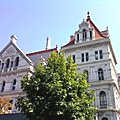- By -Staff
- News
 Print
Print  School district tax levies in the 2012-13 school year are limited to average increases of 3 percent under a new property tax cap law, in addition to any further increases approved by voter overrides of the cap, according to a preliminary analysis of data released today by State Comptroller Thomas P. DiNapoli’s office.
School district tax levies in the 2012-13 school year are limited to average increases of 3 percent under a new property tax cap law, in addition to any further increases approved by voter overrides of the cap, according to a preliminary analysis of data released today by State Comptroller Thomas P. DiNapoli’s office.“The majority of school districts are meeting the new spending limits,” said DiNapoli. “The average growth allowed under the law amounts to about 3 percent but there are some school districts with double digit reductions or increases because of how the formula is calculated.”
Under the new property tax cap enacted in 2011, school districts’ tax levies may grow at a specific percentage based on a formula in the law. School districts may present a budget that is within the tax levy limit, which must be approved by a simple majority of voters. Or they may opt to present a budget that exceeds the limit, which must be approved by a 60 percent supermajority of voters. Districts that fail to pass a budget under either scenario could ultimately be required to adopt a contingency budget that allows no growth from the 2011-2012 school year tax levy.
The formula in the law allows school districts to account for certain exclusions, such as capital expenditures, payments in lieu of taxes (PILOTs) and pension costs, when calculating their tax levy. These adjustments can cause wide variations among tax levies from school district to school district. This year’s calculated limits ranged from a 43 percent reduction in levy growth in one district to a 32 percent levy growth increase in another.
The analysis also revealed that higher rates of allowable growth occurred in school districts categorized as “high needs” due to their student profiles and relative wealth.
The law requires school districts to report how they calculated their tax levy limits to the Comptroller’s office by March 1 each year. All of New York’s districts have done so this year and their data is available on the Comptroller’s Open Book New York website. The actual tax levies have not yet been reported by the school districts and will not be known until after the public votes on school budgets, which happens statewide on May 15.
v8i16



